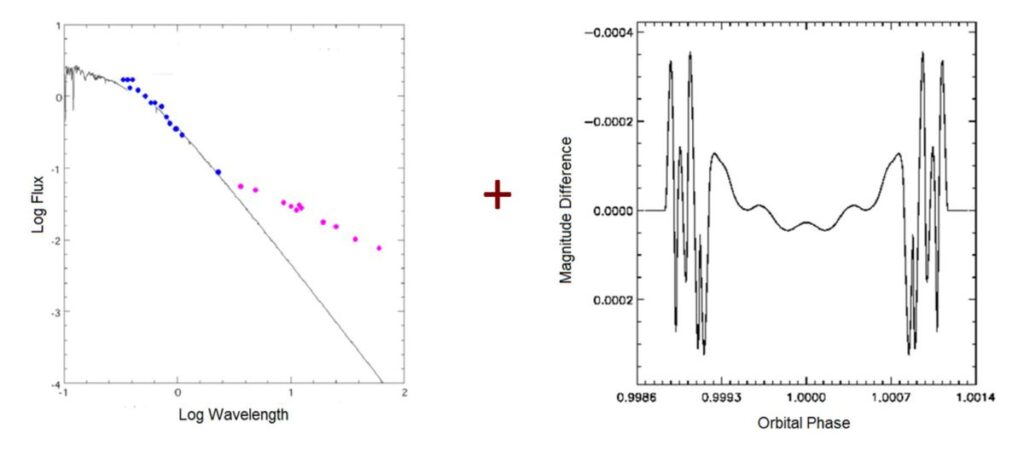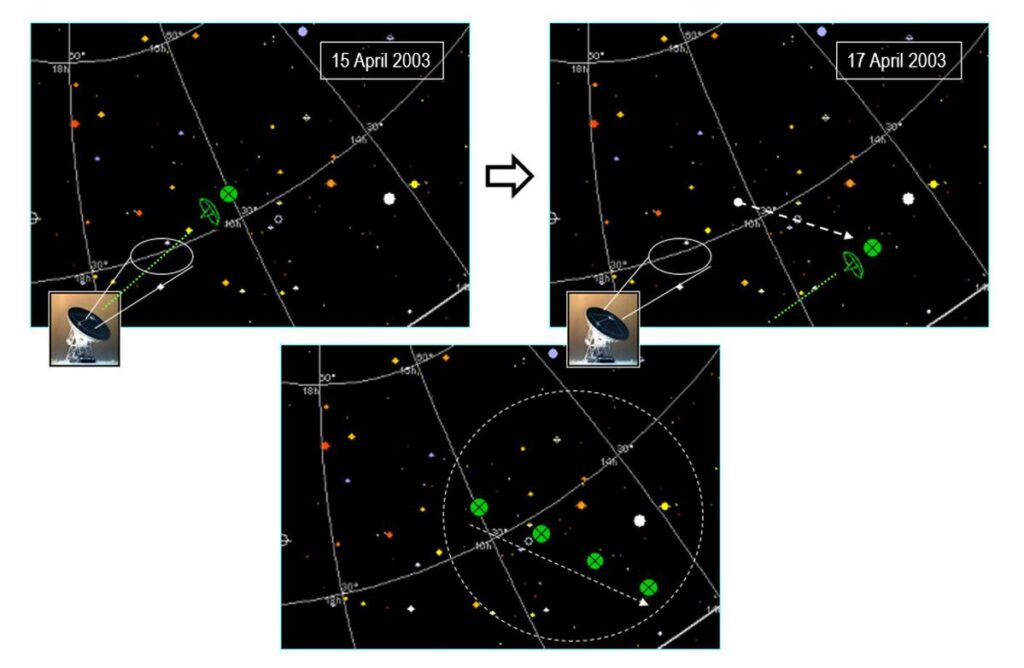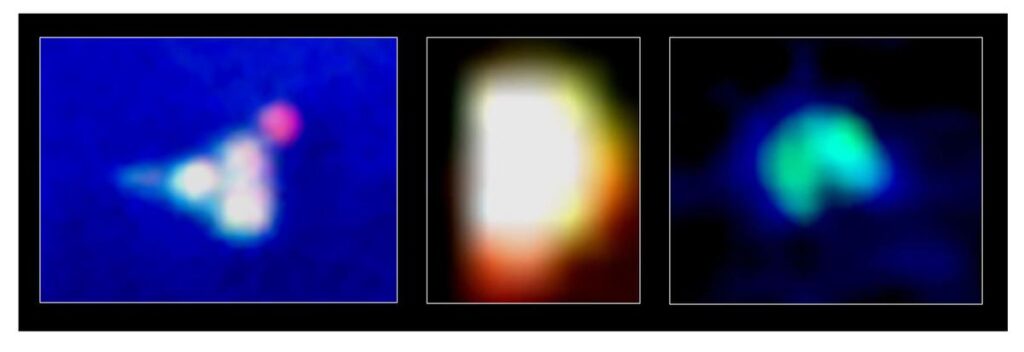Massimo Teodorani
Published in EdgeScience 53
The Universe is very big, and the possibility that we humans are alone in space is logically and scientifically unacceptable. Solar-type stars, whose lifetime can reach up to five billion years, are numerous according to astronomical statistics and can host planets, some of which have already been discovered and placed in the habitability zone where the phenomenon of life can be born and grow. The very long duration of nuclear fuel that is burning in these stars can give enough time for a civilization to develop technologically during one or more evolutionary cycles unless nuclear self-destruction occurs. The laws of physics are the same everywhere in the universe. Therefore, there are good reasons to suppose that their discovery follows very similar paths as ours. In such a way, using, at least in the first phase, electromagnetic waves to communicate, would be a natural process. Assuming that such a technological evolution reaches much higher peaks over a reasonably long time, exploring the universe directly would be natural as well. Science is presently searching for both possibilities.
SETI Research
For at least 40 years, the scientific search for extraterrestrial intelligence has been the prerogative of the SETI project (Search for Extraterrestrial Intelligence), mainly managed by the SETI Institute and directed by astronomers such as Jill Tarter and Seth Shostak. The basic concept of SETI is that to demonstrate the existence of other intelligences, it is necessary to be able to detect evidence showing that our cosmic neighbors are able to send signals in space, either in the form of radio waves – the band of microwaves between 1 and 10 GHz – or in the form of pulsed laser signals in optical wavelengths. Indeed, in order to achieve this result, the standard SETI project is based on the use of both radio telescopes and optical telescopes.
In the first case, the radio telescopes are connected to multi-channel spectrum analyzers capable of scanning 10-100 million frequencies simultaneously with a precision that reaches 1/10 of Hz on a bandwidth that, on average, can be around 10 MHz. This is like looking for a needle in a haystack, since, despite the great penetrative capability of microwaves into interstellar space (without being absorbed), such a signal is disturbed by a whole series of noises, ranging from the emission of cosmic sources up to the interference caused by human emitters such as cell phones. To be sure that it is really an intelligent alien signal, it will not only have to exceed the noise threshold by at least seven times, but it will have to be characterized by a “Doppler effect.” In fact, the emitted signal will have to be periodically shifted towards the blue or the red since it is expected that an antenna that is located on a planet, which is rotating and orbiting around its star, sometimes approaches us and sometimes moves away. Obviously, this signal must also have a whole series of other characteristics that allow us to identify it as intelligent; polarization and narrow bandwidth are two of them.
Instead, in the case of optical investigations, pulsed laser signals are sought with a frequency of the order of a nanosecond (one billionth of a second), because particularly advanced civilizations are expected to be able to send from their planet very high-power signals (up to one Terawatt), pulsed and modulated in such a way as to contain a coded message in them. The effect will be the momentary outshining of the mother star during the time in which the laser beam will be aligned with the line of sight. The method of sending pulsed signals also saves energy. In order to detect signals of this kind, it is necessary to connect an optical telescope to a photon counting detector – such as the Multi Pixel Photon Counter that is in use at Lick Observatory, Mt Wilson, California, allowing a very high time resolution.
In both types of investigation, considering that an electromagnetic signal attenuates with the inverse of the square of the distance as the distance from the source increases, using the tools we have available today, we could be able to lock on a signal produced by alien civilizations that are at a distance not exceeding 100-1000 light years, i.e., a distance at least 100 times smaller than the global extension of the Milky Way. Both in the case of radio and optical investigations, it is also essential that any intelligent signals detected by an observer on Earth can be detected continuously – with the exact same celestial coordinates – by any other observer located at different points of the planet. This would represent a validation of the alien reality of the signal.
What has been found in 30 years of tireless investigations using these two research methods? Other than a countless number of false alarms caused by various sources of noise and interference, both internal to the detection instrument and external to it, nothing has been yet revealed (Lazio et al., 2002; Wright, 2022). There is an ongoing plan to improve the situation in the immediate future by increasing the number of detection channels, i.e., increasing the bandwidth and frequency resolution used, increasing the sensitivity of radio receivers and optical photomultipliers, improving the algorithms that are used to analyze the signal, increasing the photon collecting area of radio and optical telescopes, and extending the space on the celestial sphere on which the survey can be carried out at simultaneous times. It may be then that in the not-too-distant future, such an extraterrestrial signal will be detected.
“What has been found in 30 years of tireless investigations using these two research methods? Other than a countless number of false alarms caused by various sources of noise and interference, both internal to the detection instrument and external to it, nothing has been yet revealed.”
Nevertheless, even if that were the case, what kind of signal would we have detected using these methods? With the highest probability, that would be a signal produced by civilizations that are technologically comparable to ours or a bit more advanced. There is nothing to complain about the canonical search methods used by the SETI protocol; technologically speaking, they are flawless (the author of this article, among other things, has dealt with them in the past). However, looking at things more scientifically, it is not difficult to realize that not only are these methods limited, since there is a tendency to “anthropomorphize” the other possible civilizations, but also that this is certainly a very uneconomical method. Above all, this would be a method affected by a drastic selection effect. This is because a) being able to grasp a civilization in an era of technological development similar to (or slightly superior to) ours would be a really big fluke since it is highly unlikely to be able to detect contemporary civilizations, which would be even more improbable if we look at such limited distances; b) civilizations not yet sufficiently evolved are not yet able to send signals of any kind; c) much more advanced civilizations than ours might have given up radio waves and laser signals long ago since they would be able to visit us directly.
As it can be seen, therefore, the standard SETI project, although characterized by extremely refined sensors and undoubtedly rational tactical procedures, lacks strategy. No wonder then that there have still been no results in 30 years. There are probably smarter ways (strategically and scientifically) to search for extraterrestrial intelligence.
If we limit ourselves to the current expectation that we can look for technological aliens only by trying to pick up signals that they might send from their own planet (intentionally or not), then it can be easily calculated that we would have – in our own galaxy alone – a one in a billion chance of being able to find the evidence of intelligent extraterrestrials. According to the Drake formula, it can be calculated that there are no more than 100 or 1000 technological civilizations in our galaxy, and this is out of a possible 1000 billion planets it contains. The conditions for life are very rare, and even more so for intelligence.
Engineering the Circumstellar Space
The SETT project (Search for Extraterrestrial Technology) is a relatively recent branch of SETI and has the main goal of searching for evidence of techno signatures from exogenous intelligences. In order to accomplish this task, we must start, as French astronomer Luc Arnold already did with his mathematical simulations, from the photometric study of the light of distant stars in order to verify whether the periodic decrease of their light could be due to periodic occultation caused by the “eclipse” effect produced by large celestial structures of an artificial nature orbiting in front of these distant suns (Arnold, 2005). The shape of the light curve at minima might tell us that the occultation effect is not caused by a planet orbiting around the mother star, but rather by a giant technological structure characterized by a very particular geometry.
At the same time – as a parallel study – we could search for the possible excess of infrared radiation that is expected to be emitted by stars similar to the Sun – usually characterized by a very weak emission in this wavelength window – around which a super-civilization may have built an immense technological grid in order to extract energy. Calculations show that such a grid would be able to produce much infrared radiation. This would be caused by a “shell” surrounding the star, made of many orbiting artificial planetoids, and called a “Dyson sphere” (Carrigan, 2004; Dyson, 1960). The shell would partially collect the light coming from the central star and reradiate it at a much lower temperature. The reradiated energy is expected to be an infrared blackbody spectrum with a characteristic temperature in the range of 150-500 °K. Solar-type stars have a hydrostatically stabilized structure, with no mass loss and consequently with no circumstellar envelope. If we found one which was manifested by an infrared excess, then that can only be due to an artificial structure.
Both manifestations – peculiar light curves and infrared excess from stars of a solar spectral type – can be studied using both normal telescopes connected to photon-counting detectors characterized by very high temporal resolution, and infrared space telescopes such as the James Webb currently in orbit. These are very sophisticated, rigorous, technically ready, and highly feasible research projects. In a further phase, the search for possible technosignatures from solar-type stars would be used as an optimum “viewfinder” in order to address standard SETI research in a more targeted way, i.e., the search for intelligent signals coming from stars that show the signs of extraterrestrial technology in their circumstellar space (Teodorani, 2014a).

simulation of an anomalous light curve (right, Arnold 2005).
“…peculiar light curves and infrared excess from stars of a solar spectral type – can be studied using both normal telescopes connected to photon-counting detectors characterized by very high temporal resolution, and infrared space telescopes such as the James Webb currently in orbit.”
Interstellar Migration
Astrophysics – in particular, the theory of stellar evolution – tells us that stars like ours, where life could exist, can last at least one billion years. This is the time taken by hydrogen to burn thermonuclearly inside them until completely consumed and before expanding into the red giant phase. Some planets that happen to orbit around these stars, mainly of G spectral type, could have had plenty of time, not only to generate life in its most complex forms but also to develop intelligence at extreme levels, up to the ability to build up unimaginable technologies, such as those able to allow these intelligences to roam undisturbed in the galaxy and perhaps beyond. In essence, some intelligences may have gained the capability to migrate anywhere (Deardorff, 2005; Finney, 1985; Jones, 1981; Newman et al., 1981). At this point, the Drake equation should be enriched by one more multiplicative parameter: the migration parameter (Walters et al., 1980). This parameter would increase by at least one million times the number of existent, intelligent civilizations in the galaxy, which presumably would stay for relatively short times on colonized planets, spending most of their time traveling in space. In fact, specific calculations based on the so-called “diffusion equations” prove that the colonization process carried out by advanced extraterrestrial civilizations would manifest as a migratory flux similar to a real “wave” with a growth rate of one-thousandth of light-years per year. In this way, the entire galaxy could be entirely colonized in a period of the order of 60 million years, or in a time that is at least 150 times less than the age of the galaxy itself. Therefore, not only does there exist plenty of time to colonize the galaxy and, therefore, the planets of our solar system, including the Earth, but the visits that interest us – i.e., those on planet Earth – could have already occurred at least 10,000 times over the last 2000 years. Obviously, there is still no scientific evidence that all this has actually happened, but there are some factors that stimulate us to consider this research worthy.
Regarding the possibility of interstellar migration, there are new ongoing projects intending to verify the presence of any alien probes within the solar system, near the Earth itself, and inside its atmosphere. This was born about twenty years ago with the denomination of SETV (Search for Extraterrestrial Visitation) (Stride, 2001), and it continues with the more developed Galileo Project led by Harvard astrophysicist Avi Loeb. According to the SETV strategy, the entire solar system would be meticulously monitored using wide-field monitoring systems such as PAN-STARRS, optical and infrared telescopes, and also radio telescopes used both as receivers and as large radars, in order to detect the possible presence and/or transit of robotic probes or large mobile space stations called “Dyson arcs,” hypothesized a few decades ago by physicist Freeman Dyson. These arcs are hypothesized to be pieces of a preexistent swarm coming from a Dyson sphere originally surrounding a star engineered by very intelligent beings and put in motion towards interstellar space for a purpose, such as the possible escape from the expanding envelope of a star that is becoming a red giant.
It is expected that possible objects inside the solar system possess a very high proper motion and a strong infrared signature (Teodorani, 2014b). Obviously, we already know which peculiar signatures they would show, especially if compared with the more common asteroids and comets – and in fact, due to this reason, specific astronomical instruments have already been chosen, including gamma-ray detectors from space. We know that some space civilizations visiting the solar system could also use matter-antimatter annihilation as a propulsion system – in addition to sails driven by the radiation pressure, which might emit sudden gamma-ray bursts within or just outside the solar system (Harris, 1986).
Something of these interstellar intruders might have been already discovered by chance with the Oumuamua object a few years ago (Shmuel & Loeb, 2018), and a systematic project in order to discover these kinds of objects in the future is currently being prepared by a very specific branch of the Galileo Project.
Anomalous “stars” that appear and vanish from sky maps in a matter of a few hours are not easily interpreted as transient phenomena in some kind of known “variable stars,” and must be investigated further (Villarroel et al., 2022). Analogously, fast extremely intense outbursts of energy emitted in the radio band, such as the FRBs (Fast Radio Bursts) so far cannot find a clear and definitive explanation in terms of known astrophysical phenomena such as magnetars or black holes (Lingam & Loeb, 2017).

Destination Earth?
If galactic civilizations that are far more advanced than ours are able to move from one star to another, they might be able to visit the Earth, too (Loeb, 2021). Anomalous phenomena, or “UAP” (Unidentified Anomalous Phenomena), reported in our atmosphere might be a signature of such visitations. This is another important branch of the Galileo Project (Watters et al., 2022). Which of these phenomena are due to natural or manmade causes, and which ones are not? In all cases, we would have something important to learn, also in the field of fundamental physics.
Anomalous phenomena in the Earth’s sky have shown several behaviors, ranging from so-called “nocturnal lights” to apparently structured crafts (Hynek, 1972) that cannot be identified with known technology, and which often show kinematic and light emission characteristics that are unusual and apparently not explainable by known physics laws (Maccabee, 1999; Knuth et al., 2019; Teodorani, 2004; Vallee, 1998). Most of these manifestations can be identified as misinterpretations of known manmade and natural phenomena (Condon, 1969; Pettigrew, 2003) or as mere hoaxes, especially in this era in which CGI technology can create fake movies and photos. Independently from this and so far, witnesses are the main “data” that can be evaluated. Unless we have at our disposal an overpopulated database with which acceptable statistics can be built up, human testimony of anomalous phenomena – although interesting per se for human and social sciences – cannot be used as evidential proof for physical science.
If we suppose that the Earth is visited by intelligent extraterrestrial beings, we should expect to see possibly transient anomalies in our atmosphere that have a technological signature and behavior, especially in terms of speed, luminosity and morphology, that cannot be produced by human technology (Teodorani, 2000). The difficult task here is to distinguish very carefully which ones of these anomalies are of natural origin (Brovetto & Maxia, 1995; Freund, 2003; Smirnov, 1994; Stenhoff, 1999; Zou, 1995), which ones are a product of advanced terrestrial technology, and which ones cannot be identified with the first two categories. Once the third category is suspected to be the result of an exogenous visitation, the next task consists of trying to understand how this category works in terms of the known laws of physics. This involves the investigation of possible propulsion systems (Meessen, 2012), which might be identified from the radiative processes in a wide range of wavelengths, and the investigation of how such devices are intelligently driven. For instance, the capability to identify a Zeeman effect in the spectral lines of a luminous object at night would allow us to measure the magnetic field within the produced plasma and the way in which its intensity varies with speed, optical and infrared luminosity, color, radar signature, radio emission, and sound. In such a way, crucial physical information could be inferred from the effects produced by some kind of propulsion mechanism.
“If we suppose that the Earth is visited by intelligent extraterrestrial beings, we should expect to see possibly transient anomalies in our atmosphere that have a technological signature and behavior, especially in terms of speed, luminosity and morphology, that cannot be produced by human technology.”
It is generally expected that such hypothesized intrusions in our atmosphere occur transiently and randomly on Earth, so these occurrences cannot be predicted in order to allow researchers to be prepared with sensing instrumentation. In such a case, instrumented scientific investigations would not be possible. Instead, in order to do science on this kind of investigation, it is necessary to acquire physical data using well-calibrated multimode and multi-wavelength measurement sensors, through which the signals of interest and the related measurement errors can be accurately evaluated.
Fortunately, in addition to the transient occurrence of anomalous events on Earth, there is also strong evidence that in some areas of Earth, atmospheric anomalies occur with remarkable regularity (Rutledge, 1982). Such locations can be suitably chosen as the best sites for scientific monitoring in order to ascertain the nature of the phenomenon, including a possible extraterrestrial origin too. For instance, this has happened since 1984 in the area of Hessdalen in Norway, where up to ten sightings per square kilometer in a radius of about 5 Km have been reported every year. In this specific location, research has been carried out using measurement instrumentation (Teodorani, 2004). So far, the results of this scientific investigation do not show that “Earth is being visited,” but rather prominent anomalies in the behavior manifested by the observed phenomenon. Hessdalen is not the only world location of interest regarding recurring anomalous phenomena; for instance, areas such as Catalina Island, the Yakima reservation, Brown Mountain, the Hudson Valley, the Uintah Basin, Piedmont, and Marfa in the United States are worthy of investigation.
One fundamental goal of this research is aimed at trying to understand the physics of the observed phenomena, especially the confinement mechanism of plasma, which manifests as “nocturnal lights” characterized by strong light and color variability, sudden multiplicity, unusual kinematic behavior, and often by electromagnetic interference (Rodeghier, 1981). Sometimes plasma-like “light balls” overlap with the transient apparition of apparently-structured objects: the reason for this connection is not known yet, but it must be investigated in-depth.
Whatever the phenomenon is, identifying the physical mechanism is, without a doubt, our main goal, even if what is observed gives the impression of sometimes defying the laws of physics themselves. We can investigate all of this using exactly the same posture that we use in astrophysics and the standard methodology of science. The correct approach is to maintain an aseptic equidistance from both hypotheses: natural or non-natural. Physics is the only real issue that matters here, whatever the nature of the phenomenon may be.
The key to unveiling the physics of what is observed in the skies of the world consists not only in measured “static characteristics” such as spectra, CCD images, or luminosity distribution but, above all, in the phenomenon’s time variability within a wide range of wavelengths. Just this second approach allowed us to understand the physical mechanism that is working in celestial objects such as Cepheid stars, quasars, accretion disks, close binary stars, pulsars, gamma-ray bursts, or star spots. The ways in which physical parameters vary with time were able to tell us much of what we already know in astrophysics, namely the dynamics of celestial objects. This same procedural philosophy can also be applied to UAP, especially nocturnal lights. Multi-wavelength observations of strongly varying phenomena, kinematically, photometrically, and electromagnetically, using properly calibrated instruments, can allow us to understand the physical mechanism on which such phenomena are based. This means acquiring data, in 24h and automatic mode (Watters et al., 2022).
The interpretation of these dynamics can help us to understand quantitatively what is going on by subjecting such data to mathematical modeling. This is exactly what we do in astrophysics. An aseptic and agnostic aptitude, which is what science actually is, can tell us if what comes out from the data is the result of a natural phenomenon, a mere misinterpretation of known natural or manmade phenomena, or a propulsion mechanism that is not known to us yet. This can come out only from the measured data, not from preconceived belief systems of whatever nature. This is in the name of Galileo, which should always be alive in the mind of physical scientists.

About The Author

Massimo Teodorani (PhD., Bologna University) is an astrophysicist from Northern Italy. He has a Ph.D. in Astronomy from Bologna University with a specialization in stellar physics. He has been carrying out research on eruptive phenomena in astrophysics, such as supernovas, novas, high-mass close binary stars with neutron star components, black hole candidate binary star systems, strongly eruptive protostars (FU Orionis type), and cataclysmic and pre-cataclysmic stars. He is an expert in photometric and spectroscopic observational techniques. He has been working as a researcher at the Italian National Institute of Astrophysics (INAF). Being experienced both in optical and radio astronomy, in a subsequent phase, Dr. Teodorani carried out research on extrasolar planets and the Search for Extraterrestrial Intelligence (SETI). Recently, Dr. Teodorani taught physics at Bologna University, and he is a well-known science communicator in Italy about subjects such as astrophysics, quantum physics, and anomalistics. He has studied UAP phenomenon for many years. He has been a research affiliate of The Galileo Project (Harvard University). In his free time, he is a composer of electronic music.
References
Arnold, L. F. A. (2005). Transit light-curve signatures of artificial objects. Astrophysical Journal, 627(1), 534-539.
Brovetto, P. & Maxia, V. (1995). On the instability of ionospheric plasma originated by the charge separations in the troposphere. The “UFO” phenomenon mechanism. Il Nuovo Cimento, 17(2), 169-202.
Carrigan, R.A., Jr. (2004) Searching for Dyson Spheres with Planck spectrum to IRAS. Proceedings of the 55th International Astronautical Congress, Vancouver, Canada. IAC-04-IAA-1.1.1.06.
Condon, E. U. (1969). Scientific study of unidentified flying objects. University of Colorado, Bantam Books.
Deardorff, J., Haish, B., Maccabee, B., & Puthoff, H. E (2005). Inflation theory implications for extraterrestrial visitation. Journal of the British Interplanetary Society, 58, 43-50.
Dyson, F. (1960). Search for artificial stellar sources of infrared radiation. Science, 131(3414), 1667–1668.
Finney, B. R. (1985). SETI and interstellar migration. Journal of the British Interplanetary Society, 38, 274-276.
Freund, F. (2003). Rocks that crackle and pparkle and glow: Strange pre-earthquake phenomena. Journal of Scientific Exploration 17(1), 37-71.
Harris, M. J. (1986). On the detectability of antimatter propulsion spacecraft. Astrophysics and Space Science, 123, 297-303.
Hynek, J. A. (1972). The UFO experience: A scientific inquiry. Contemporary Books.
Jones, E. M. (1981). Discrete calculations of interstellar migration and settlement. Icarus, 46, 328-336.
Knuth, K. H., Powell, R. M., & Reali, P. A. (2019). Estimating flight characteristics of anomalous unidentified aerial vehicles. Entropy, 21(10), 939.
Lazio, T. J. W., Tarter, J., Backus, P. R. (2002). Megachannel extraterrestrial assay candidates: No transmissions from intrinsically steady sources. Astron. J. 124, 560-564.
Lingam, M. & Loeb, A. (2017). Fast radio bursts from extragalactic light sails. Astrophysical Journal, 837, L23.
Loeb, A. (2021). A possible link between ‘Oumuamua and unidentified aerial phenomena. Scientific American, June 22, 2021.
Maccabee, B. (1999). Optical power output of an unidentified high altitude light source. Journal of Scientific Exploration, 13(2), 199-211.
Meessen, A. (2012). Pulsed EM propulsion of unconventional flying objects. PIERS Proceedings, Moscow, Russia, August 19–23, 2012.
Newman, W. I., & Sagan, C. (1981). Galactic civilizations: Population dynamics and interstellar diffusion. Icarus, 46, 293-327.
Pettigrew, J. D. (2003). The Min Min light and the Fata Morgana: An optical account of a mysterious Australian phenomenon. Clinical and Experimental Optometry, 86(2), 109-120.
Rodeghier, M. (1981). UFO Reports Involving Vehicle Interference: A Catalogue and Data Analysis. Center for UFO Studies.
Rutledge, H. (1982). Project identification: The first scientific field study of UfO phenomena. Prentice Hall Direct.
Shmuel, B., & Loeb, A. (2018). Could solar radiation explain ʻOumuamua’s peculiar acceleration? Astrophysical Journal, 868 (1), L1.
Smirnov, B. M. (1994). Long-lived glowing phenomena in the atmosphere. Physics-Uspekhi, 37, 517–521.
Stenhoff, M. (1999). Ball lightning: An unsolved problem in atmospheric physics. Springer.
Stride, S. I. (2001). An instrument-based method to search for extraterrestrial interstellar robotic probes. Journal of the British Interplanetary Society,54, 2-13.
Teodorani, M. (2000). Physical data acquisition and analysis of possible flying extraterrestrial probes by using opto-electronic devices. Extraterrestrial Phys. Rev. 1(3), 32-37.
Teodorani, M. (2004). A long-term scientific survey of the Hessdalen phenomenon. Journal of Scientific Exploration, 18(2), 217-251.
Teodorani M. (2014a). A strategic “viewfinder” for SETI Research. Acta Astronautica, 105, 512–516.
Teodorani, M. (2014b). Search for high-proper motion objects with infrared excess. Acta Astronautica, 105, 547-552.
Wright, J. T. (2022). SETI in 2020. Acta Astronautica, 190, 24-29.
Vallee, J. (1998). Estimates of optical power output in six cases of unexplained aerial objects with defined luminosity characteristics. Journal of Scientific Exploration, 12(3), 345-358.
Villarroel, B. Mattsson, L. Guergouri, H., Solano, E., Geier, S., Dom, O.N., & Ward, M.J. (2022). A glint in the eye: Photographic plate archive searches for non-terrestrial artefacts. Acta Astronautica, 194, 106-113.
Walters, C., Hoover, R. A., & Kotra, R. K. (1980). Interstellar colonization: A new parameter for the Drake equation? Icarus, 41(2), 193-197.
Watters, A. W., Loeb, A., Laukien, F., Cloete, R., Delacroix, A., Dobroshinsky, S., Horvath B., Kelderman, E., Little, S., Masson, E., Mead, A. Randall,M. Schultz, F. Szenher, M., Vervelidou, F., White, A., Ahlström, A. Cleland, C., Dockal, S. Donahue, N., … Zorzano, M. (2023). The scientific investigation of unidentified aerial phenomena (UAP) using multimodal ground-based observatories. Journal of Astronomical Instrumentation, 2(1), 2340006.
Zou, Y. S. (1995). Some physical considerations for unusual atmospheric lights observed in Norway. Physica Scripta, 52, 726–730.





Leave a Reply
You must be logged in to post a comment.